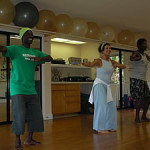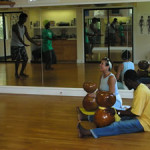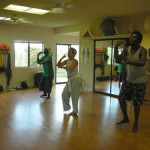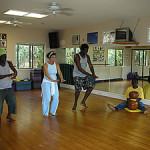Aloha Africa 2009: A Rewarding Experience
I am so fortunate to be able to give the gift of hula. I have had a handful of inspiring na kumu hula (hula teachers). But, my main resource, Roselle Keli’ihonipua Bailey has been the most inspirational kumu hula in my life. I honor my teachers and their teachers before them by passing on the knowledge. This is how one keeps culture alive. Aloha Africa- a cultural exchange, the brain-child of isa Maria, has been accomplishing just that. isa Maria has made many personal sacrifices and worked persistently to bring three Ghanaian artists to share their skills of traditional music and dance with Kaua’i.
Ernest Borketey, Nii Anang and Obuobi Ashong were initially to arrive together with Mercy Fofoe Addy, a female dancer/instructor, but, because her visa application was not approved, the three men came on their own. The disappointment of Mercy’s absence became a blessing in disguise as it became an opportunity for Nii Anang to teach the traditional dances and songs of their homeland, Ghana. With Obuobi and Ernest on musical accompaniment, as well as, the constant musical support from Kaua’i members Paul Jardin and isa Maria on drums, and I on percussion, classes were enjoyed by regular participants.
Each Thursday Ernest, Nii Anang and Obuobi would come to my home for two hours of hula instruction. isa was alaka’i (lead dancer/assistant) for the class, actively supporting my instruction. Obuobi willingly took on the role of ho’opa’a (chanter/drummer), while Ernest and Nii Anang practiced their skills as ‘olapa {dancer}. They learned to enter the dance platform with Ho’opuka, and then, presented Huki I Ke Kalo and Ula No Weo, traditional ipu hula. Obuobi’s guitar skills made it seem easy for them to learn Kanaka Waiwai, a hula noho (kneeling hula). They worked very hard to learn and pronounce the ‘olelo, the words of the song, which they sang all together in beautiful rich harmonies while dancing. I gave Obuobi and old recording of Na Kaholokula playing the song, Kanaio. He memorized it and has performed it beautifully with isa dancing and singing along with him. It is a delight to the senses. They, as well as the other members of the ensemble, have learned the chant, “Aloha Tatou”. The rich and varied voices of our welcoming presentations have mesmerized our audiences and created a strong bond within our group.
The day before Ho’ike I brought them up the mountain to Koke’e to gather palapalai fern. I taught them to hili (braid) the ferns into leis for their presentation at our final concert. We went to the first Kalalau lookout to oli (chant) to the place, but, there was construction work being done and the noises and distractions made it very unfavorable to enjoy the view. In addition, the noe noe (mist) was so very thick. All we could see was white. So, we decided to go to the second lookout. We sat on a grassy patch near the edge of the valley to eat our lunch and wait. “Waiting fills/Perseverance futhers” and as we waited, we chanted “O Kalalau” towards/into the valley. Lo and behold, the ancestors were listening because the mist parted and we were given a magical view of the pali (ridge). Mahalo ke Akua
With all our rehearsals and preparations behind us, we were ready for our ho’ike (show) the next evening. The auditorium was filled to capacity. The energy level was high and as the contagious energy continued to build, the audience was out of their seats and dancing with joyful enthusiasm. There was no separation between performer and audience. There was only lokahi (unity).”Ekome fee moh”(togetherness) is the Ghanaian expression. A feeling of mutual admiration and a celebrated time was experienced by all.
Our time together is (finished) pau for now, but we are forever connected through the music and the dance. Aloha Africa 2009-cultural exchange has truly been a successful experience. We have realized the oneness in All.





